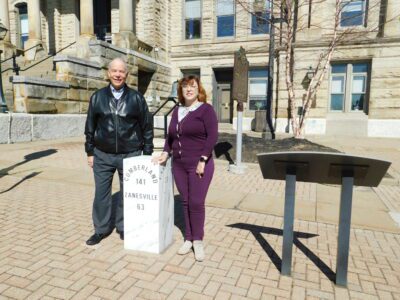National Road mile markers replaced
ST. CLAIRSVILLE — New markers are visible along the historic National Road to mark this vital piece of Ohio history.
John S. Marshall and Cathryn Stanley, Belmont County’s representatives to the Ohio National Road Association, a volunteer organization established to promote, preserve and protect the roadway and its history, said they are looking back to when the road was first laid.
“The historic National Road was the very first interstate highway. Federally funded, it was started in 1808. The ground was broken in 1825 in Ohio here in St. Clairsville. The Congress required along this road there be mile markers every mile along the road, and the mile marker designated on every one the distance from Cumberland, Maryland, which was where it began. That’s where it started,” Marshall said. “It also included the distance from the next city or two cities on the marker.”
However, Marshall said the markers are 150 years old and many are badly weathered or have gone missing over the years, so the association has taken it upon itself to replace them.
“Just in December they replaced five in this county,” Marshall said.
He added this is done using grants from the Ohio Department of Transportation.
In 2021, the association replaced mile marker 141 that stood in front of the Belmont County Courthouse
“That was funded by the Tourism Council, the Rotary club, because that was not along the right-of-way. The city was responsible for that,” Marshall said.
The original marker is preserved at the Belmont County Heritage Museum next door to the courthouse.
He said there are about five mile markers in Belmont County the association still wants to replace.
“We hope to do that in the next few years,” he said.
There is no schedule for the work at this time.
“That’s kind of up in the air at this point, because we’re just finishing a $100,000 grant through ODOT, and we have to apply for another grant, which would help us to complete the project, although we are doing some local funding through different organizations.”
He said the former sandstone markers are being replaced by granite markers, which should hold up better in the weather. The cost of a marker is about $3,000, with an additional $3,000 for an interpretive sign. Not all of the markers will have interpretive signs, only sites of historical interest.
The latest marker was placed near the Ebbert Farm, off U.S. 40 east of St. Clairsville.
“We worked for a long time in getting that in there and together,” Marshall said.
Stanley added they were looking into designing signs to better go with some of the markers.
“They’re going to look more like the historical markers, at least this one is. This is a test to see how we want to do the interpretive signs moving forward.”
The sign near Ebbert Farm would be paid for by the Belmont County Tourism Council and the Ebberts.
Marshall said most of the markers are obelisk shaped, but some including the one in front of the courthouse are square. Stanley said the government specifies the location of the markers, but the material and shapes were not standardized.
“The markers that are replaced go to museums,” Marshall said. “The original from near Ebbert Farms is in the Smithsonian Institute.”
He added that in the 1930s the original marker was donated when that part of the highway was being rebuilt.
Marshall considered the significance of the National Road in the country’s development.
“Wheeling and Bridgeport were actually the gateways to the west. The reason this was built was because the country was growing, and there was no access past Virginia, so it really opened up the west to merchants, to settlers who wanted to go west into the Northwest Territory.”
Marshall said the National Road lost importance as rail and then interstate highways rose to prominence.
“Morristown was a booming town when it was on the National Road. When the railroads came however, the railroads went through Barnesville in Belmont County.
He reflected that in many areas people are not aware of how much the land had changed over the years from the dense woodlands of the past.
“There’d be conestoga wagons with their chickens inside, the kids and the stoves,” he said. “It’s so important to keep this history alive.”
Stanley added National Road regained some prominence with the rise of bicycling. Marshall agreed.
“It went into some disrepair over the years. With the bicycle craze, that kind of reinvigorated it,” he said.
“In the western part of the state there are many (markers) that have just disappeared,” he said.
There are still sections of the original National Road in Morristown, and near the Napa Auto Parts store at 51660 National Road East, in St. Clairsville.
They said more information about the association can be found on its Facebook page. Assistance is always welcome.
“We’re always looking for members who would like to support the organization,” Marshall said.
“Just anyone who is interested in history,” Stanley said.









